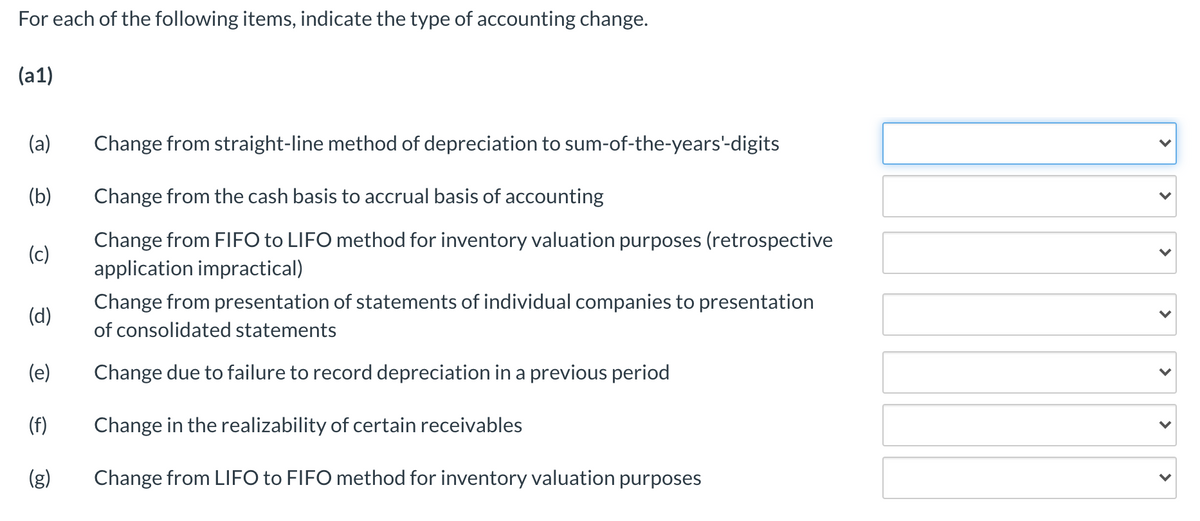For each of the following items, indicate the type of accounting change. (a1) (a) Change from straight-line method of depreciation to sum-of-the-years'-digits (b) Change from the cash basis to accrual basis of accounting Change from FIFO to LIFO method for inventory valuation purposes (retrospective application impractical) (c) Change from presentation of statements of individual companies to presentation (d) of consolidated statements (e) Change due to failure to record depreciation in a previous period (f) Change in the realizability of certain receivables (g) Change from LIFO to FIFO method for inventory valuation purposes > > > > >
For each of the following items, indicate the type of accounting change. (a1) (a) Change from straight-line method of depreciation to sum-of-the-years'-digits (b) Change from the cash basis to accrual basis of accounting Change from FIFO to LIFO method for inventory valuation purposes (retrospective application impractical) (c) Change from presentation of statements of individual companies to presentation (d) of consolidated statements (e) Change due to failure to record depreciation in a previous period (f) Change in the realizability of certain receivables (g) Change from LIFO to FIFO method for inventory valuation purposes > > > > >
Intermediate Accounting: Reporting And Analysis
3rd Edition
ISBN:9781337788281
Author:James M. Wahlen, Jefferson P. Jones, Donald Pagach
Publisher:James M. Wahlen, Jefferson P. Jones, Donald Pagach
Chapter22: Accounting For Changes And Errors.
Section: Chapter Questions
Problem 2E
Related questions
Question

Transcribed Image Text:For each of the following items, indicate the type of accounting change.
(a1)
(a)
Change from straight-line method of depreciation to sum-of-the-years'-digits
(b)
Change from the cash basis to accrual basis of accounting
Change from FIFO to LIFO method for inventory valuation purposes (retrospective
application impractical)
(c)
Change from presentation of statements of individual companies to presentation
(d)
of consolidated statements
(e)
Change due to failure to record depreciation in a previous period
(f)
Change in the realizability of certain receivables
(g)
Change from LIFO to FIFO method for inventory valuation purposes
>
>
>
>
>
>
>
Expert Solution
This question has been solved!
Explore an expertly crafted, step-by-step solution for a thorough understanding of key concepts.
This is a popular solution!
Trending now
This is a popular solution!
Step by step
Solved in 2 steps

Knowledge Booster
Learn more about
Need a deep-dive on the concept behind this application? Look no further. Learn more about this topic, accounting and related others by exploring similar questions and additional content below.Recommended textbooks for you

Intermediate Accounting: Reporting And Analysis
Accounting
ISBN:
9781337788281
Author:
James M. Wahlen, Jefferson P. Jones, Donald Pagach
Publisher:
Cengage Learning

Auditing: A Risk Based-Approach (MindTap Course L…
Accounting
ISBN:
9781337619455
Author:
Karla M Johnstone, Audrey A. Gramling, Larry E. Rittenberg
Publisher:
Cengage Learning

Financial Reporting, Financial Statement Analysis…
Finance
ISBN:
9781285190907
Author:
James M. Wahlen, Stephen P. Baginski, Mark Bradshaw
Publisher:
Cengage Learning

Intermediate Accounting: Reporting And Analysis
Accounting
ISBN:
9781337788281
Author:
James M. Wahlen, Jefferson P. Jones, Donald Pagach
Publisher:
Cengage Learning

Auditing: A Risk Based-Approach (MindTap Course L…
Accounting
ISBN:
9781337619455
Author:
Karla M Johnstone, Audrey A. Gramling, Larry E. Rittenberg
Publisher:
Cengage Learning

Financial Reporting, Financial Statement Analysis…
Finance
ISBN:
9781285190907
Author:
James M. Wahlen, Stephen P. Baginski, Mark Bradshaw
Publisher:
Cengage Learning

Principles of Accounting Volume 1
Accounting
ISBN:
9781947172685
Author:
OpenStax
Publisher:
OpenStax College

Survey of Accounting (Accounting I)
Accounting
ISBN:
9781305961883
Author:
Carl Warren
Publisher:
Cengage Learning
